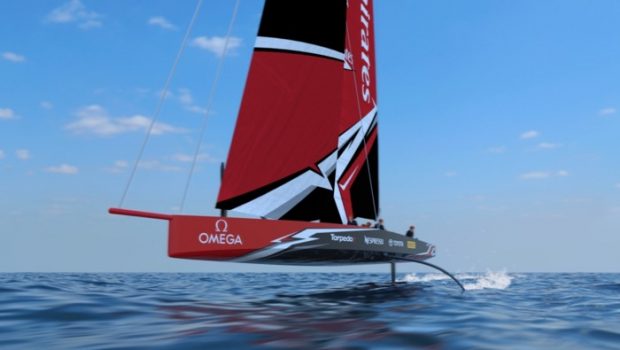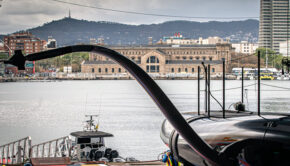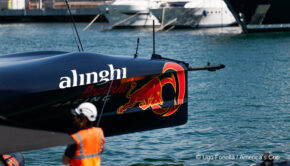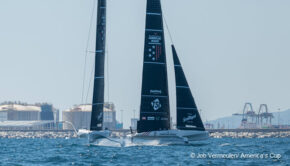Team New Zealand set to Reveal AC75
Published on September 3rd, 2019
The build up to the next America’s Cup is about to become serious with the defender launching its first boat in Auckland on Friday, September 6, 2019. Team New Zealand’s design team has spent months working behind closed doors on their radical foiling monohull, and will be the first to splash the 23-metre AC75, which is expected to be faster than the catamarans that were used in Bermuda.
CEO Grant Dalton believes the boat launch will be decisive to their chances of retaining the Auld Mug. “On the face of it, it looks normalish,” said Dalton. “But once it starts to roll, once it starts to get up on the foils it won’t look like a boat, it will look like an aircraft.”
“The America’s Cup is actually over, we just don’t know who won yet because decisions you make very early set the pattern of what will happen two, three years in time. Once that boat rolls out of the shed it won’t even get halfway out before it’s already in Europe and the United States.”
While the teams will build a second version that will do the racing in Auckland in 2021, most of the major design decisions have already been made meaning, 18 months out, the winner could already be decided. So far the boat’s been shrouded in secrecy, which is why spies from the other teams will be at the Team New Zealand base when they launch.
Team New Zealand have hung the triumphant catamaran from Bermuda on the side of their Auckland base. It’s a clear sign Team New Zealand have well and truly moved on, and won’t be dwelling on past glories but determined to create new ones. “It’s going to be life-changing for us. It’s unbelievable,” Duncan said of the new boat, feeling the Team NZ version had benefited from an increased input by the key sailors in this cycle.

Team New Zealand will start a flurry of launches by the Cup heavyweights with Luna Rossa, American Magic and INEOS Team UK quick to follow. While these teams will build second versions of the 75-foot foiling monohull that will do the racing in Auckland in 2021, most of the big decisions in the design race have now been made. Tweaks can be made, but major u-turns are more likely to end in tears than champagne.
“I think the teams, after they see each other’s boats will come together a bit (with their second generation boats). But there’s not a lot of time now. People have got to start designing their second boats and it would be quite a big thing now to change direction.
“There has been two years of research gone on already. It’s probably too extreme to say it’s won or lost, but there’s a pattern established now, there’s a set of railway tracks that would be pretty hard to get off now,” Duncan expressed.
Dalton likes what has come out of the team’s boatyard though admits to nerves for the initial sailing period when the boat will be calibrated and systems double-checked. “I have no idea how right or wrong we are, nobody does,” he said.
“But I see a very coordinated team that is hitting its goals in terms of timing, that gets on well, and is functional. So we do have a very coherent team, more coherent than I’ve ever seen.” Duncan sees huge gains for the sport as the Cup looks to take its knowledge from three cycles of multihull sailing and a foiling revolution back to the monohull scene.
The field may be small – there are four challengers with rookie outfit Stars + Stripes Team USA joining the heavyweights – but Dalton insists it will be worthy. Deep opposition pockets mean the Kiwis, so innovative in design and competent under sail, know they are in for a real test.
Dalton won’t say the 36th edition of sport’s oldest trophy looks the most competitive at this stage, but he believes it could be unrivalled in terms of intensity. “Everybody always says that about being the most competitive and while you all look competitive at the start, as time goes by you start to see who is good and who is bad.
“I think in terms of the energy that each of the teams is bringing to it, the intensity, I don’t think I have seen that before. The English, they just say nothing, they are quietly going about it and that is a worry.
“Probably the Americans are saying more about it than anyone and it’s all good stuff. We have studied their test boat, they aren’t making any mistakes that are obvious at this point.”
America’s Cup AC75 in numbers:
Hull length: 20.7m plus 2m bowsprit
Maximum beam: 5m
Weight: 6.5T
Mast height: 26.5m from deck
Sails: 135-145sqm mainsail, 90sqm jib, 200sqm code zero
Rudder: Centreline T foil, 3.5m maximum draft, 3m maximum span
Foils: Twin-canting T foils, 5m maximum draft, 4m wing span
Crew: 11 sailors (960-990kg combined weight)
In addition to Challenges from Italy, USA, and Great Britain that were accepted during the initial entry period (January 1 to June 30, 2018), eight additional Notices of Challenge were received by the late entry deadline on November 30, 2018. Of those eight submittals, entries from Malta, USA, and the Netherlands were also accepted. Here’s the list:
Defender:
• Emirates Team New Zealand (NZL)
Challengers:
• Luna Rossa (ITA) – Challenger of Record
• American Magic (USA)
• INEOS Team UK (GBR)
• Malta Altus Challenge (MLT) – WITHDRAW
• Stars & Stripes Team USA (USA)
• DutchSail (NED) – WITHDRAW
Of the three late entries, only Stars+Stripes USA remains committed, but they still must complete the entry fee payment process before they will be eligible to race. They have already paid their initial payment but as a late entry challenger under the Protocol they also have a liability to pay a US$1million late entry fee due in installments by October 1, 2019. This deadline coincides with the venue schedule which has the construction of their team base beginning in late 2019, which we assume was done in the event the team is unable to fulfill their payment deadline.
Key America’s Cup dates:
✔ September 28, 2017: 36th America’s Cup Protocol released
✔ November 30, 2017: AC75 Class concepts released to key stakeholders
✔ January 1, 2018: Entries for Challengers open
✔ March 31, 2018: AC75 Class Rule published
✔ June 30, 2018: Entries for Challengers close
✔ August 31, 2018: Location of the America’s Cup Match and The PRADA Cup confirmed
✔ August 31, 2018: Specific race course area confirmed
✔ November 30, 2018: Late entries deadline
✔ March 31, 2019: Boat 1 can be launched (DELAYED)
✔ 2nd half of 2019: 2 x America’s Cup World Series events (CANCELLED)
October 1, 2019: US$1million late entry fee deadline
February 1, 2020: Boat 2 can be launched
April 23-26, 2020: First America’s Cup World Series event in Cagliari, Sardinia.
During 2020: 3 x America’s Cup World Series events
December 10-20, 2020: America’s Cup Christmas Race
January and February 2021: The PRADA Cup Challenger Selection Series
March 2021: The America’s Cup Match
Details: www.americascup.com









 We’ll keep your information safe.
We’ll keep your information safe.